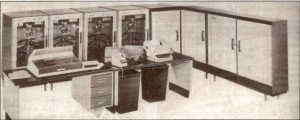National-Elliott 803B computer
Two machines from the English-made 803 series arrived in Hungary; these were the first semiconductor computers in our country.
Use
In keeping with the spirit of the times, each user institution solved its own characteristic tasks.
Institute of Industrial Economics and Operations Management of the Ministry of Heavy Industry ( NIM IGÜSZI )
Ministry of Metallurgy and Mechanical Industry ( KGM ) Ferrous Metallurgy Directorate
Informatics History Exhibition (incomplete copy)
Structure
Word-organized machine: 39 + 1 (parity) bpW
Central unit
- control unit:
- control (instruction counter and interpreter) registers
- address arithmetic
- main memory: 8 KW ferrite ring RAM (2*4 KW/block
- calculator:
- 39-bit accumulator register
- 38-bit q-register, for performing double-length operations
- floating point operation unit
- channel: instead of interface circuits for connecting external units
Periphery
- backups:
- up to 4 magnetic tape units with a capacity of 16 KW each
- external devices:
- control panel
- line printer, 132 chpl, 120 lpm
- up to two 5/8 lane punched tape readers, 200 chps
- up to two 5/8 lane hole punches, 100 chps
Operation
The machine word could contain two instructions and a modifier, "B" bit, or a fixed-point or floating-point binary number.
Structure of the machine instruction:
- opcode: 6 bits (64 instructions)
- address part: 13 bits (to address 8192 words)
- In case B = 1, the contents of the memory location specified by the address part of the first instruction were added to the second instruction before execution, so indexing could be implemented
Instruction types:
- internal data traffic (battery – main storage)
- elementary operations (addition, subtraction, multiplication, division, logical AND)
- steps
- program control
- peripheral and other control operations
The main memory address of the current instruction was contained in the instruction counter register (IC), noting whether the first or second instruction was next in line. After the second instruction was executed, the contents of IC were automatically incremented by 1; or in the case of a jump instruction, its address was included.
The parity bit was automatically generated by the machine when writing and checked when reading; it stopped in case of an error
The calculator performs operations with 39-bit 2's complement fixed-point fractions [-1
One factor of the operations was the current contents of the accumulator, for two-factor operations the other factor was contained in the main storage register, where the current address data was loaded simultaneously with the decoding of the operation code.
The result was stored in the accumulator; if it did not fit, an “overflow” error occurred. In the case of fixed-point operations, this was only indicated by the Overflow light on the control panel, but in the case of floating-point overflow, the FlpOverflow light came on and the machine stopped.
Operating speeds:
- 1700 fixed-point "short" ips
- 1100 floating point “short” and 700 “long” ips
- 40 – 90 fixed-point “long” ips (multiplication, division, shifts)
Punched tape devices were controlled by direct machine instructions, so the central unit was in a "busy" state during their operation.
The other external units (magnetic tape, line printer) were activated by the controller with a preparatory instruction, but were released after the execution instruction was issued, because the data traffic was automatically handled by the local controllers.
Program set
- operating system: none, the programmer had to define the storage structure of the program to be run
- compilers:
- machine code interpreter
- Elliott autokód
- Algol 60
- library set of mathematical subroutines (Later, several new subroutines were developed independently in the two computing centers to solve more complex tasks; as a result, the two machines were no longer compatible)
To solve specific tasks, numerous unique programs were written for both machines; in NIM IGÚSZI, among others:
- Solving economic problems (e.g. price matrix analysis)
- Solving construction, electrical and chemical industry tasks
- Delivery, optimization and linear
solving programming problems, regression calculations - Solving administrative automation tasks
- CDL Prolog compiler
- Compiler programs for the EMG 830 computer (DOS, Autocode)
- Drawing machine (Graphomat) control programs
Detailed list: NIM IGÜSZI publications
Historical curiosities
The country's first two semiconductor-based computers were mainly used by central authorities, key industrial institutions, and military development institutions:
- the first one in 1961 by NIM IGÜSZI,
- the second in 1963 by the KGM Ferrous Metallurgy Directorate
received it and then operated it.
Since they had no operating system and only basic mathematical and peripheral control routines, users had to develop the programming tools necessary to solve individual tasks, which made the two systems incompatible.
Resources
Detailed description: Géza Álló: Elliott 803B computer
Reminiscence: Géza Álló: The Elliott (video)
The story of “home”: Miklós Havass: THE NIM IGÜSZI Computing Center
Created: 2015.12.29. 20:34
Last modified: 2024.07.06. 16:30

